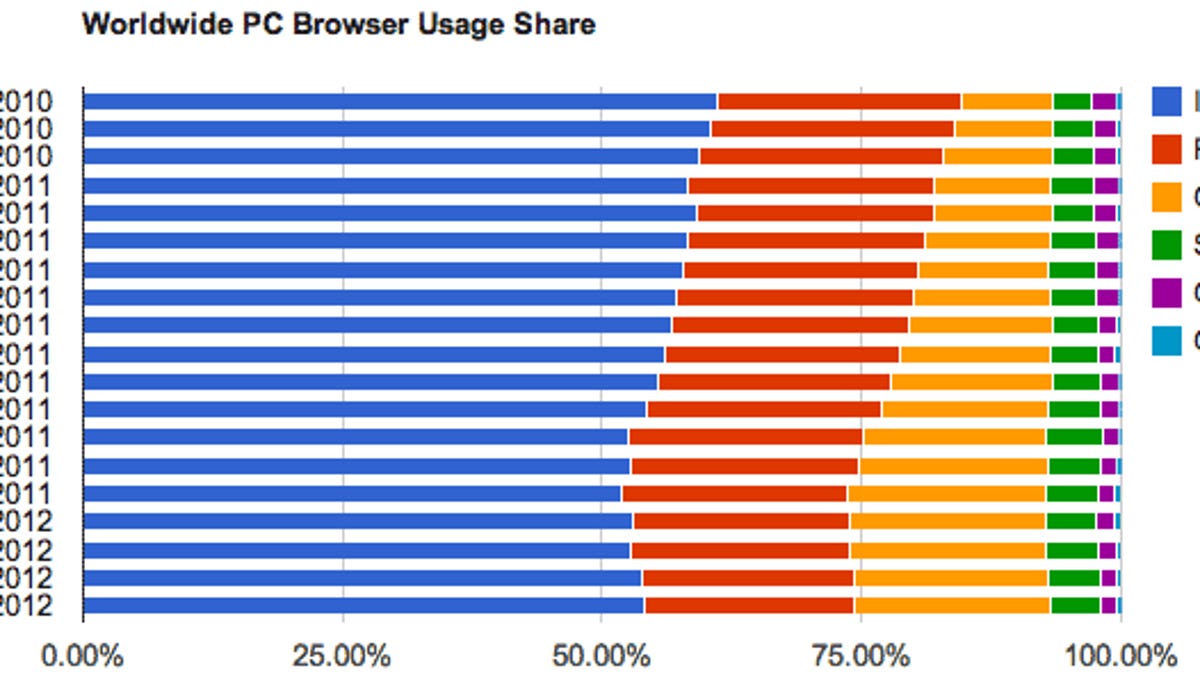IE continues to rebound in browser market
Microsoft's browser, after years of declines, reclaimed some share of its share of usage from rivals in April by one measurement.

The reversal of Internet Explorer's ill fortunes appears less likely to be a fluke with the release of April statistics for Web browser usage.
Net Applications' global browser statistics, updated today, showed the top browser reclaiming a sliver of usage from its rivals, growing from 53.8 percent in March to 54.1 percent of usage in April on personal computers.
The top rivals kept their rankings overall. No. 2. Firefox held dropped from 20.6 percent to 20.2 percent; Chrome rose from 18.6 percent to 18.9 percent; Safari dropped from 5.1 percent to 4.8 percent; and Opera held level at 1.6 percent.
Microsoft is heavily pushing IE9, which requires Windows Vista or Windows 7 and which restores some of the competitiveness that Internet Explorer has lacked for years. The company also is trying hard to move IE6 users off the decade-old browser and has begun promoting the forthcoming IE10 version that'll ship with Windows 8.
But among mobile devices -- phones and tablets -- Microsoft continues to be weak.
There, Safari usage grew considerably from 60.5 percent to 63.8 percent, Net Applications said. Google's Android browser grew from 18.3 percent to 18.9 percent, and Opera Mini dropped from 15.4 percent to 12.1 percent.
The mobile market has been more volatile in Net Applications' measurements, so gains and losses have been more fleeting, but Safari seems to have no trouble maintaining its strong lead, at least for now. No doubt Google hopes to change that with its new Chrome version for Android.
The split between mobile and PC browsing stayed about level, with 92.4 percent of usage on personal computers and 7.3 percent on mobile devices.
Net Applications said the iPad now handily tops the iPhone in mobile device usage. iPads account for 33.7 percent of mobile device browser usage to 27.4 percent for iPhones.
Meanwhile, StatCounter, an alternative analytics site with different methods, shows No.1 IE continuing to slide, No. 2 Chrome rising but not as fast as in previous months, and No. 3 Firefox about level.
StatCounter counts raw page views, not qualifying its data by daily usage, pre-rendered pages in Chrome that may not ever actually be viewed, and geographic differences with global Internet usage patterns vs. its own analytics network. Net Applications does make those adjustments to its data. Both firms gather data based on global visits to Web pages that include its tracking technology.
Updated 5:42 a.m. PT to add the April data to the PC browsing chart. Updated 12:18 a.m. PT May 2 to note that IE9 requires Windows Vista or Windows 7.

